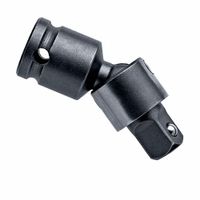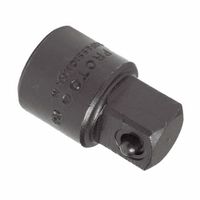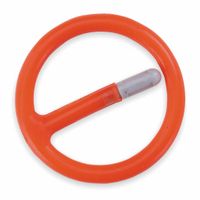Call +(254) 703 030 000 / 751 483 999 / 721 704 777
- Home
- Tools
- Sockets Bits
- Socket Adapters Extensions Accessories
- Impact Socket Adapters Extensions Accessories
.....Read More
Frequently Asked Questions
What is the difference between impact socket adapters and regular socket adapters?
Impact socket adapters are designed to withstand the high torque and vibrations produced by impact tools, such as impact wrenches or drivers. They are typically made from stronger materials like chrome molybdenum steel, which provides greater durability and resistance to wear and tear. These adapters often have a black oxide or phosphate coating to prevent corrosion and are engineered to absorb and distribute the force of impact, reducing the risk of cracking or breaking.
Regular socket adapters, on the other hand, are intended for use with hand tools or non-impact power tools. They are usually made from chrome vanadium steel, which is sufficient for the lower torque levels associated with these tools. These adapters often have a polished chrome finish for corrosion resistance and ease of cleaning. Regular socket adapters are not designed to handle the intense forces of impact tools and can fail if used improperly in such applications.
In summary, the primary differences lie in the materials used, the design for handling torque and impact, and the intended applications. Impact socket adapters are built for heavy-duty use with impact tools, while regular socket adapters are suitable for lighter, non-impact tasks.
How do I choose the right size impact socket adapter?
To choose the right size impact socket adapter, follow these steps:
1. **Determine Drive Size**: Identify the drive size of your impact wrench or ratchet. Common sizes include 1/4-inch, 3/8-inch, 1/2-inch, 3/4-inch, and 1-inch. The adapter must match the drive size of your tool.
2. **Identify Socket Size**: Determine the size of the sockets you intend to use. The adapter should convert the drive size of your tool to the drive size of the socket.
3. **Material and Strength**: Choose an adapter made from high-strength materials like chrome molybdenum or chrome vanadium steel, which are designed to withstand the high torque of impact tools.
4. **Length and Design**: Consider the length of the adapter. Longer adapters can provide better reach but may reduce torque efficiency. Ensure the design is suitable for your application, such as a universal joint adapter for angled access.
5. **Brand and Quality**: Opt for reputable brands known for quality and durability. Check for any warranties or guarantees offered.
6. **Set or Individual**: Decide if you need a single adapter or a set. A set can offer versatility for different applications.
7. **Safety Features**: Look for features like a locking mechanism to secure the socket and prevent it from slipping off during use.
8. **Compatibility**: Ensure the adapter is compatible with both your tool and sockets. Check for any specific recommendations from the tool or socket manufacturer.
9. **Budget**: Consider your budget but prioritize quality and durability over cost to ensure safety and performance.
By considering these factors, you can select the right impact socket adapter for your needs.
Can impact socket adapters be used with regular sockets?
Yes, impact socket adapters can be used with regular sockets. Impact socket adapters are designed to withstand the high torque and vibrations produced by impact tools, such as impact wrenches or drivers. They are typically made from stronger materials, like chrome molybdenum, and are often thicker and more robust than standard socket adapters. This makes them suitable for heavy-duty applications.
When using an impact socket adapter with regular sockets, there are a few considerations to keep in mind:
1. **Material Compatibility**: Regular sockets are usually made from chrome vanadium, which is not as strong as the materials used for impact sockets. While the adapter can handle the stress, the regular socket may not be able to withstand the high torque and could potentially crack or shatter.
2. **Safety**: Using regular sockets with impact tools can be risky. If the socket fails, it can cause injury or damage to the tool or workpiece. Always ensure that the socket is securely attached to the adapter and that you are wearing appropriate safety gear.
3. **Performance**: Regular sockets may not perform as efficiently as impact sockets when used with impact tools. Impact sockets are designed to absorb and distribute the force more effectively, reducing the risk of damage to both the socket and the fastener.
4. **Application**: For light-duty tasks or when precision is not critical, using an impact socket adapter with regular sockets may be acceptable. However, for heavy-duty or critical applications, it is advisable to use impact-rated sockets to ensure safety and performance.
In summary, while it is possible to use impact socket adapters with regular sockets, it is generally recommended to use impact-rated sockets for optimal safety and performance when working with impact tools.
What materials are impact socket adapters typically made from?
Impact socket adapters are typically made from materials that can withstand high torque and impact forces. The most common materials include:
1. **Chrome Molybdenum Steel (Cr-Mo):** This is a popular choice due to its excellent strength and durability. It can handle the high stress and torque associated with impact tools, making it ideal for heavy-duty applications.
2. **Chrome Vanadium Steel (Cr-V):** While not as strong as chrome molybdenum, chrome vanadium is still a durable material that offers good resistance to wear and corrosion. It is often used for lighter-duty impact applications.
3. **Carbon Steel:** Some impact socket adapters are made from high-grade carbon steel, which provides a good balance of strength and affordability. These are typically heat-treated to enhance their durability and performance.
4. **Alloy Steel:** This is a general term for steel that has been alloyed with other elements to improve its mechanical properties. Alloy steel impact socket adapters are designed to offer high strength and toughness.
5. **Heat Treatment:** Regardless of the base material, impact socket adapters often undergo heat treatment processes to enhance their hardness and resistance to deformation under stress.
6. **Surface Coatings:** Many impact socket adapters feature surface coatings such as black oxide or phosphate to provide additional protection against rust and corrosion.
These materials and treatments ensure that impact socket adapters can endure the rigorous demands of impact tools, providing reliability and longevity in various industrial and mechanical applications.
How do impact flex socket adapters work?
Impact flex socket adapters work by providing a flexible connection between an impact wrench and a socket, allowing for greater maneuverability and access in tight or awkward spaces. These adapters are designed to withstand the high torque and vibrations generated by impact tools, ensuring durability and performance.
The key component of an impact flex socket adapter is its universal joint or swivel mechanism, which allows the socket to pivot at various angles relative to the tool. This flexibility enables the user to reach fasteners that are not aligned with the tool's axis, making it easier to work around obstacles or in confined areas.
The construction of impact flex socket adapters typically involves high-strength materials such as chrome molybdenum or chrome vanadium steel, which can endure the stress and impact forces without breaking or deforming. Additionally, these adapters often feature a black oxide or phosphate coating to resist corrosion and wear.
The design of the adapter includes a square drive on one end that fits into the impact wrench and a corresponding square or hex drive on the other end to attach the socket. The swivel joint is usually secured with a pin or ball detent mechanism, ensuring a secure connection while allowing for smooth rotation.
Overall, impact flex socket adapters enhance the versatility and efficiency of impact wrenches by enabling users to tackle a wider range of applications, particularly in automotive, construction, and industrial settings where access to fasteners can be challenging.
Are impact socket extensions necessary for all applications?
Impact socket extensions are not necessary for all applications, but they are crucial in specific scenarios. These extensions are designed to withstand the high torque and vibrations produced by impact tools, making them essential when using impact wrenches or drivers. They are constructed from tougher materials, often chrome molybdenum, to prevent shattering or breaking under stress.
In applications where high torque is required, such as automotive repair or heavy machinery maintenance, impact socket extensions ensure safety and efficiency. They reduce the risk of tool failure, which can lead to injury or damage to the workpiece. Additionally, they provide better performance by maintaining the torque transfer from the tool to the fastener.
However, for applications involving hand tools or where precision and lower torque are sufficient, standard socket extensions are adequate. These are typically used in light-duty tasks or where impact tools are not involved. Using impact extensions in these scenarios is unnecessary and may be cost-inefficient due to their higher price.
In summary, the necessity of impact socket extensions depends on the specific application. They are indispensable for high-torque, impact tool applications but not required for standard, low-torque tasks.
How do you secure impact sockets to power wrenches using retaining rings and pins?
To secure impact sockets to power wrenches using retaining rings and pins, follow these steps:
1. **Select the Correct Retaining Ring and Pin**: Ensure that the retaining ring and pin are compatible with both the socket and the power wrench. They should match the size and specifications of the drive anvil and socket.
2. **Inspect the Socket and Anvil**: Check the socket and the anvil of the power wrench for any damage or wear. The retaining groove on the anvil and the hole on the socket should be clean and free of debris.
3. **Align the Socket**: Place the socket onto the anvil of the power wrench. Align the hole in the socket with the groove on the anvil.
4. **Insert the Retaining Pin**: Slide the retaining pin through the hole in the socket. Ensure it passes through the groove on the anvil. The pin should fit snugly without excessive force.
5. **Attach the Retaining Ring**: Position the retaining ring over the pin. Stretch the ring slightly if necessary, and fit it into the groove on the anvil. The ring should snap into place, securing the pin and socket.
6. **Check the Connection**: Gently tug on the socket to ensure it is firmly attached to the power wrench. The socket should not wobble or detach easily.
7. **Test the Setup**: Operate the power wrench at a low speed to confirm that the socket remains secure during use.
8. **Regular Maintenance**: Periodically inspect the retaining ring and pin for wear and replace them if necessary to maintain a secure connection.
By following these steps, you ensure a secure and reliable connection between the impact socket and the power wrench, enhancing safety and performance.



